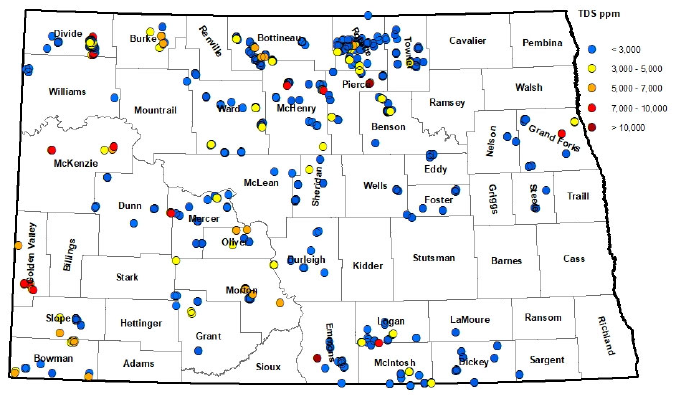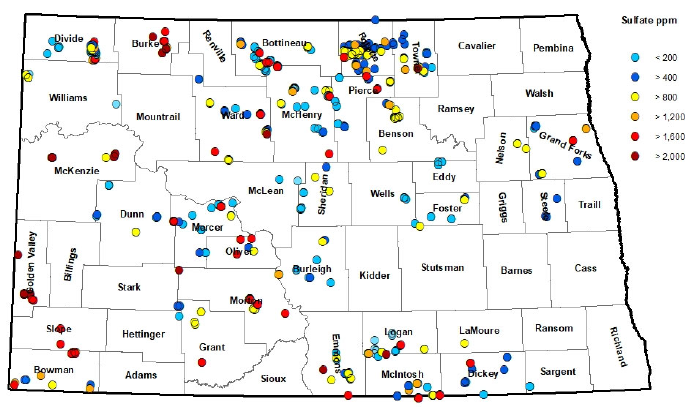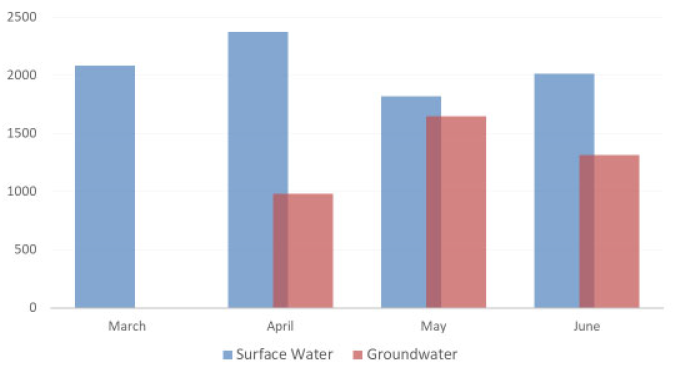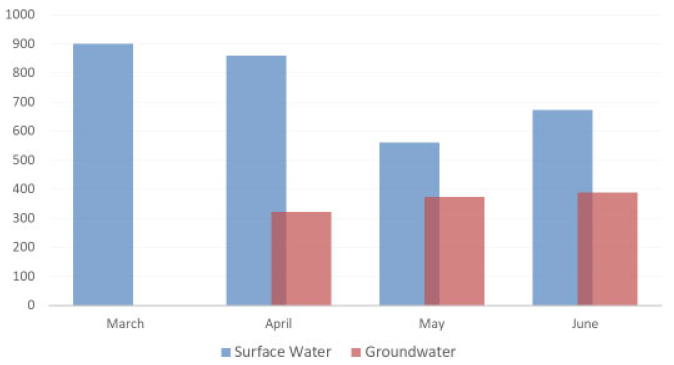To date, 740 samples have been screened for TDS and samples displayed high variability ranging from 125 to 16,640 ppm (Table 1, Figure 1). The majority of the samples screened (624, 84%) are acceptable for livestock consumptions, with TDS concentrations below 3,000 ppm. At TDS concentrations between 3,000 and 5,000, feed conversion and intake can decline thus reducing livestock performance.
Table 1. Total dissolved solid concentrations of water samples.
| Total Dissolved Solids (TDS) in ppm |
Groundwater |
Surface Water |
| < 3,000 |
72 |
552 |
| 3,000 – 5,000 |
3 |
65 |
| 5,000 – 7,000 |
|
30 |
| 7,000 – 10,000 |
|
14 |
| > 10,000 |
|
4 |
Figure 1. Total dissolved solids (TDS) in ppm of water sources screened in 2021.
The TDS of 19 samples were between 3,000 and 5,000 ppm. Concentrations of TDS between 5,000 and 7,000 ppm were reported for one sample, and water with this concentration of TDS tends to have a laxative effect. Pregnant or lactating ruminants should not consume water with TDS between 7,000 and 10,000 ppm, and three samples fell in this range.
Concentrations of TDS exceeding 10,000 ppm consumption can result in brain damage or death, and three sample exceeded 10,000 ppm. Of the samples collected, 48 exceeded 5,000 ppm and were recommended to be sent to a laboratory for additional analyses.
To date, 671 samples have been screened for sulfates and samples displayed high variability ranging from less than 200 to 11,626 ppm (Table 2, Figure 2). Negative impacts to livestock health can occur when concentrations exceed 1,000 ppm for mature animals and 500 ppm for calves. Concentrations above 2,000 ppm in forage-based diets and 600 ppm in high-concentrate diets (equal to or greater than 85%) pose a risk of central nervous system disorders and death. Of the samples collected, 182 exceeded 800 ppm and were recommended to be sent to a laboratory for additional analysis.
Table 2. Sulfate concentrations of water samples.
| Sulfates in ppm |
Groundwater |
Surface Water |
| < 200 |
42 |
269 |
| > 400 |
12 |
146 |
| > 800 |
9 |
90 |
| > 1,200 |
3 |
31 |
| > 1,600 |
|
50 |
| > 2,000 |
|
20 |
Figure 2. Sulfates in ppm of water sources screened in 2021.
Variability was observed between and within groundwater and surface water sources. Overall, groundwater had less variability and was higher quality than surface water sources (Figures 3 and 4). The average TDS and sulfate concentrations of groundwater sources was 1,315 ppm and 361 ppm, respectively. The majority (85%) of groundwater samples screened were acceptable for livestock consumption.
Figure 3. Average total dissolved solids (TDS) in ppm of water sources by month in 2021.
Figure 4. Average sulfates in ppm of water sources by month in 2021.
The TDS of surface water varied in quality ranging from 125 to 16,640 ppm, with an average of 2,074 ppm. The sulfate concentration of surface water varied in quality ranging from 100 to 11,626 ppm, with an average of 748 ppm. The TDS concentration was considered acceptable for 83% and the sulfate concentration was considered acceptable for 68% of surface water samples.
To understand the variation in water quality during the grazing season, samples were divided by month (Figures 1 and 2). Typically, TDS and sulfates tend to increase in surface waters as the grazing season progresses because of increased evapotranspiration rates in the summer months. However, fall drought and low spring runoff can influence this trend. In addition, waters with extremely high TDS and sulfates documented in March and April were not monitored in May and June because livestock no longer were allowed to access these sources.
Water quality screening and analysis of livestock sources allows ranchers to ensure water quality is not impacting livestock performance and/or health. It also can aid in making management decisions such as when livestock should be removed from a pasture or when an alternative water source should be used or developed. Installing a water development plan can help ensure that livestock have access to good-quality water throughout the grazing season and increase a ranch’s drought resilience.
Results of these screenings will help us understand and demonstrate the variability in water quality and factors that may influence variability, including location, source and climate. The variation in the results to date reinforces the importance of monitoring the quality of water sources throughout the grazing season to ensure livestock performance and health are not impacted by water quality. If you are concerned about water quality, contact your local NDSU Extension agent and that person can conduct a screening and/or assist with sample collection and submission for laboratory analyses




